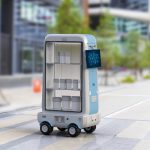Self-driving technology companies are taking a significant step with their latest collaboration. Whale Dynamic, known for its autonomous delivery vans, has partnered with Noodoe, a provider of electric vehicle charging and energy management software, to link intelligent vehicles with advanced charging infrastructure. Their announced “end-to-end ecosystem” aims to help businesses run delivery operations with minimal human intervention and zero tailpipe emissions, presenting a solution for both urban and rural logistics providers facing rising sustainability demands. These developments reflect broader efforts globally as more fleets look to merge vehicle automation with reliable, AI-enabled support systems.
Earlier reports on autonomous delivery and charging focused on solutions that required more hands-on fleet management or third-party integrations. Generally, earlier attempts by industry players centered on either logistics or on-charging, but rarely both in a seamless, AI-coordinated ecosystem. Past deployments often struggled to efficiently close the gap between dynamic route optimization, automatic charging schedules, and the user-friendly management of vehicle fleets. The latest partnership stands out by directly weaving together AI-driven system management and self-operating delivery vehicles, aiming to address operational disconnects that slowed adoption of similar technologies.
What Does Whale Dynamic Bring to Autonomous Deliveries?
Whale Dynamic, headquartered in Shenzhen, China, assembles driverless vans for campus, logistics, and last-mile delivery markets. The company builds its vehicles with integrated hardware, proprietary AI-based perception technologies, and control-by-wire systems, all designed to function in specific geofenced areas. Whale Dynamic’s platforms combine HD mapping, sensor fusion, and localization for safe and scalable automation. Its focus is on deliveries that do not rely on a human behind the wheel, presenting a potential alternative to traditional van fleets and echoing market strategies seen from companies like Nuro and their Nuro Driver platform.
How Does Noodoe’s Charging Solution Interface with Driverless Fleets?
Noodoe, based in Colorado, has developed the Electric Vehicle Operating System (EV OS), focused on orchestrating autonomous charging through AI-powered analytics. EV OS informs vehicles of the optimal time and place to charge, as well as managing payment and session scheduling automatically. According to Noodoe CEO Jennifer Chang, this type of infrastructure is essential for “seamless, zero-emission solutions” in driverless fleets. By scheduling and managing its own charging cycles, a vehicle becomes operationally independent, allowing operators to maintain services without direct oversight.
What Is the Broader Impact of Their Integrated Approach?
By connecting Whale Dynamic’s WDII delivery vans with Noodoe’s EV OS, the companies intend to deploy an integrated system for unattended, around-the-clock delivery operations. The combined setup links the vehicles’ on-board intelligence to cloud-based fleet management, presenting a “single pane of glass” for logistical oversight. The pilot demonstrations planned by Whale Dynamic and Noodoe will test the viability of AI-coordinated zero-emission deliveries at scale, aiming to set a new standard for fully autonomous fleet models.
“Reliability and efficiency are the heartbeat of autonomous delivery,” said David Chang, founder and CEO of Whale Dynamic.
Collaboration between self-driving vehicle and AI-powered infrastructure companies seeks to address persistent operational obstacles such as fleet downtime, manual intervention, and inefficient charging practices. The approach highlights the growing interplay between robotics, EV infrastructure, and cloud computing, as the logistics industry advances towards hands-off, low-emission transport.
Developments like the Whale Dynamic-Noodoe partnership indicate a direction where logistics is managed by interconnected autonomous systems covering both vehicle control and energy supply. Businesses examining lower-emission delivery options can take note of how direct vehicle-infrastructure communication and real-time analytics will contribute to operational resilience and efficiency. Fleets considering automation should assess how such integrations reduce manual workload while aligning with market and regulatory pressures for sustainable logistics. As the field matures, alliances that bundle both self-driving technology and infrastructure management may offer a more viable route than piecemeal solutions.










